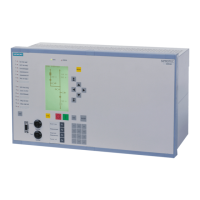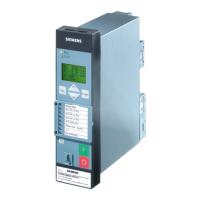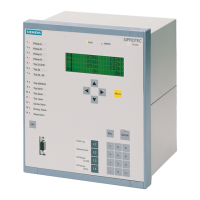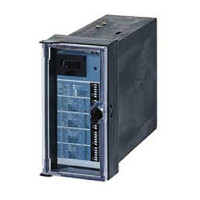NOTE
If the threshold value of the 67-1 or 67N-1 element is exceeded, the phase-specific directional indications
“forward” or “reverse” are output (indications 2628 to 2636), independent of whether the fault direction is
the same as the configured direction.
These indications are used for directional comparison protection.
Quantity Selection for Direction Determination for the Directional Ground Element
Parameter 1617 67N POLARIZAT.can be set to specify whether direction determination is accomplished
from the zero sequence quantities or ground quantities (with VN and IN) or from the negative sequence
quantities (with V2 and I2) in the ground directional element. The first option is the preferential setting;
the latter is to be selected in case of danger that the zero voltage be too small due to unfavourable zero impe-
dance or that a parallel line influences the zero system.
Directional High-set Elements 67-2, 67-3 (phases)
The high-current element 67-2 PICKUP or 67-3 PICKUP is set at address 1502 or 1528. The associated
delay 67-2 DELAY or 67-3 DELAY at 1503 or 1529. For setting, the same considerations apply as did for the
non-directional time overcurrent protection in Section 2.2.11 Setting Notes.
The selected time is only an additional time delay and does not include the operating time (measuring time,
dropout time). The delay can be set to ∞. After pickup the element will then not trip. Pickup, however, will be
signaled. If the 67-2 element or 67–3 element is not required at all, the pickup value 67-2 PICKUP or 67-3
PICKUP should be set to ∞. For this setting, there is neither a pickup signal generated nor a trip.
Directional High-set Elements 67-2, 67-3 (ground)
The high-current element 67N-2 PICKUP or 67N-3 PICKUP is set at address 1602 or 1628. The associated
delay 67N-2 DELAY or 67N-3 DELAY at 1603 or 1629. The same considerations apply for these settings as
for the phase currents.
The selected time is an additional delay time and does not include the operating time (measuring time,
dropout time). If the delay time is set to ∞, the element does not trip after the pickup, but the pickup condi-
tion is signaled. If the directional 67N-2 element or 67N-3 element is not required, set the pickup threshold
67N-2 PICKUP or 67N-3 PICKUP to ∞. This setting prevents tripping and the generation of a pickup indica-
tion.
Directional Overcurrent Element 67-1 (phases)
The pickup value of the 67-1 element (67-1 PICKUP) address1504 should be set above the maximum antici-
pated load current. Pickup due to overload should never occur since in this mode the device operates as fault
protection with correspondingly short tripping times and not as overload protection. For this reason, lines are
set to approx. 20% above the maximum expected (over)load and transformers and motors to approx. 40%.
If the relay is used to protect transformers or motors with large inrush currents, the inrush restraint feature of
7SJ62/64 may be used for the 67-1 element (for more information see margin heading "Inrush Restraint").
The delay for directional elements (address 1505 67-1 DELAY) is usually set shorter than the delay for
nondirectional elements (address 1205) since the non-directional elements overlap the directional elements
as backup protection. It should be based on the system coordination requirements for directional tripping.
For parallel transformers supplied from a single source (see "Applications"), the delay of element 67-1 DELAY
located on the load side of the transformers may be set to 0 without provoking negative impacts on selec-
tivity.
The selected time is only an additional time delay and does not include the operating time (measuring time,
dropout time). The delay can be set to ∞. After pickup the element will then not trip. Pickup, however, will be
signaled. If the 67-1 element is not required at all, the pickup value 67-1 PICKUP should be set to ∞. This
setting prevents from tripping and the generation of a pickup message.
Functions
2.3 Directional Overcurrent Protection 67, 67N
SIPROTEC 4, 7SJ62/64, Manual 101
C53000-G1140-C207-8, Edition 08.2016

